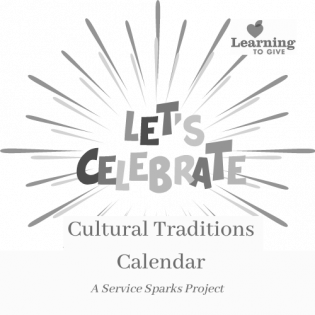Service Sparks: Cultural Traditions Calendar
Keywords:
Celebrating Differences
Cultures
Holidays
SimpleSafeService
Ignite meaningful action that lights up the world through "Service Sparks" youth projects! Add a variety of cultural holidays to your annual calendar to raise awareness of the variety of ways people celebrate their cultural traditions. Learning about other cultures helps us see the beauty in our similarities and differences. We can reflect on whether there are core values in every culture and how our differences add interest and strength to our community.
SERVICE SPARKS
Ignite meaningful action that lights up the world through "Service Sparks" youth projects!
Celebrations carry stories of families and communities and create a fun, positive climate. Often organizational calendars follow federal holiday calendars, which do not include the observances of non-dominant cultures. Federal calendars also tend to focus on religious-based observances and leave out group-based awareness months/days. In this activity, we plot a variety of cultural celebrations on our calendar and advocate for celebrating the cultural traditions of people in our groups and community.
- In order to raise awareness of the variety of ways people celebrate their cultural traditions, we are going to add a variety of cultural holidays to our annual calendar. Learning about other cultures helps us see the beauty in our similarities and differences.
- Brainstorm a list of holidays and traditions we celebrate as a group. This will likely include Christmas, Kwanzaa, and Hanukkah. Ask if everyone celebrates these holidays. Young people may raise questions about a holiday's relationship to culture, and this can be a great opportunity to discuss the different aspects of culture (ethnicity, religion, geography, values, faith).
- Have the youth work in pairs to research holidays and observances that are related to specific cultural groups (represented in your community or group). They could search the internet with terms like these:
- Awareness months
- Cultural holidays
- Major religious holidays
- Compile the findings into a list by month or directly onto a calendar. If possible, a Google calendar is helpful because it can be easily shared.
- Talk about with whom we should share the calendar of observances and how to communicate about it. The goal is to encourage people to learn and gain respect for the diversity of our community. The calendar items can be shared on a monthly or annual basis along with suggestions for activities.
- Think about the diversity of people you interact with in school, club, or the community. How would people who don't celebrate the dominant-culture holidays feel to see their cultural traditions acknowledged in your language and decor? Also think about young people who may not celebrate any holidays at all. October and December can be especially lonely for those families. Are we creating space for them within our group and classroom culture?
Reflection: Have the group also search for “U.S. National Holidays.” Compare the list of federal observances with the list of observances they compiled. What’s the same? What’s different? What group or groups are most represented in the federal calendar, and how might that make other groups feel? They can do this same comparison against their organization/school’s official calendar.
We can reflect on whether there are core values in every culture and how our differences add interest and strength to our community.
Explore more Service Sparks projects:
Learning to Give ...
- educates youth about philanthropy, the civil society sector, and the importance of giving their time, talent and treasure for the common good (knowledge),
- equips youth by encouraging philanthropic behavior and experience (skills), and,
- empowers youth to take voluntary citizen action for the common good in their classrooms, lives and communities (behavior).

